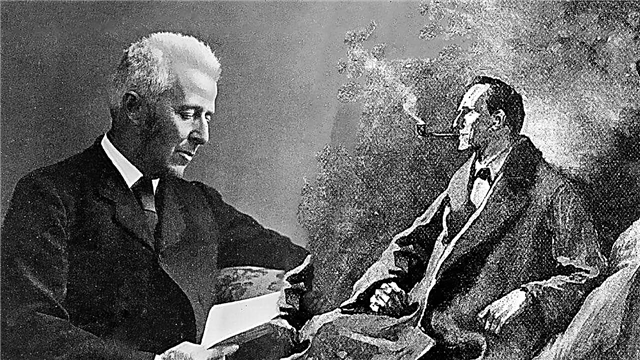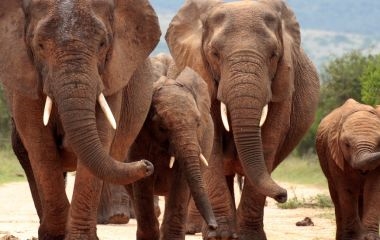Fear of snakes is as ancient as humanity itself, and “snake stories” were popular in myth and folklore of different nations long before the advent of the Internet. Instinct makes us afraid of them, and there seem to be good reasons, since many of the most poisonous creatures in the world are snakes. And the smallest of them are the most deadly.
But most of largest snakes in the world are not poisonous and are often kept as pets.
We offer you a description and photos of the largest snakes in the world.
10. Black mamba (Dendroaspis polylepis) - 3 meters in length
 In size, one of the most poisonous snakes on the planet is second only to its queen from the 6th line of our rating. It is also one of the most aggressive snakes in the world, as it often attacks for no apparent reason. And to escape from the black mamba is very difficult. At short distances, it develops a speed of up to 11 km / h.
In size, one of the most poisonous snakes on the planet is second only to its queen from the 6th line of our rating. It is also one of the most aggressive snakes in the world, as it often attacks for no apparent reason. And to escape from the black mamba is very difficult. At short distances, it develops a speed of up to 11 km / h.
9. Olive python (Liasis olivaceus) - 4 meters
 Sometimes this non-toxic snake, one of the largest in Australia, is confused with a mulga, a poisonous snake from the aspid family. First of all, the olive python suffers from this similarity, as it is often killed, mistaking it as a dangerous "double."
Sometimes this non-toxic snake, one of the largest in Australia, is confused with a mulga, a poisonous snake from the aspid family. First of all, the olive python suffers from this similarity, as it is often killed, mistaking it as a dangerous "double."
Olive pythons are harmless to humans, they feed mainly on small mammals, birds and reptiles.
8. Common boa constrictor - 4.5 meters
 These snake world chameleons can fit into any habitat in which they live. The color of an ordinary boa constrictor varies from green and brown to yellow or red.
These snake world chameleons can fit into any habitat in which they live. The color of an ordinary boa constrictor varies from green and brown to yellow or red.
Boa constrictors can be found in tropical Central and South America. They are excellent swimmers, although they prefer to live on land. They can eat anything from birds to monkeys. Ordinary boas are not poisonous, they have small hooked teeth with which they cling to the prey before wrapping their whole body around it and squeezing it to death.
However, from hunters they often turn into a victim, because for the exotic skin of boa constrictors there is a real hunt. Therefore, this type of snake is on the list of endangered.
7. Indian python, aka light tiger python (Python molurus molurus) - 5 meters
 Once this snake was the queen of the jungle of India, Sri Lanka and the East Indies. Indian pythons are among the oldest snake species and have tiny protrusions on their skin that indicate that they might have legs at one time. They are not poisonous, but they have two rows of very sharp teeth that can cause a very painful bite.
Once this snake was the queen of the jungle of India, Sri Lanka and the East Indies. Indian pythons are among the oldest snake species and have tiny protrusions on their skin that indicate that they might have legs at one time. They are not poisonous, but they have two rows of very sharp teeth that can cause a very painful bite.
Pythons prefer to eat mammals, and, like the other largest snakes in the world, they kill their prey with asphyxiation. They are able to kill a deer and swallow it whole.
Indian pythons live up to 20 years and are considered very useful creatures for pest control, such as rats and mice. In areas where people killed snakes or destroyed their habitats, pests that transmit dangerous diseases have become a serious threat to human health.
6. King cobra (Ophiophagus hannah) - 5.6 meters
 This is the largest poisonous snake in the world. It is considered a very dangerous reptile, since its poison can cause human death in 15 minutes. However, when possible, the king cobra avoids collisions with people. And during an attack, in order to drive away a bipedal enemy, he can make two or three “single” bites, saving poison for hunting.
This is the largest poisonous snake in the world. It is considered a very dangerous reptile, since its poison can cause human death in 15 minutes. However, when possible, the king cobra avoids collisions with people. And during an attack, in order to drive away a bipedal enemy, he can make two or three “single” bites, saving poison for hunting.
The Latin name Ophiophagus hannah means "snake eater." And it is fully justified, because the diet of the royal cobra mainly consists of other snakes, including poisonous ones.
5. The dark tiger python, aka Burmese python (Python bivittatus) - 5.74 meters
 This snake has a beautiful patterned color resembling the skin of a giraffe, and is known for its calm disposition. Burmese pythons are often kept as pets.
This snake has a beautiful patterned color resembling the skin of a giraffe, and is known for its calm disposition. Burmese pythons are often kept as pets.
In their natural habitat, these snakes can be found in South and Southeast Asia. Their diet consists of small mammals and birds, and, like the anaconda, Burmese pythons squeeze their prey until it suffocates. Then they swallow the whole victim and can only eat two or three times a year.
Due to the deteriorating living conditions and demand for snake skin and flesh, these giant creatures become an endangered species in the wild. However, in captivity their numbers remain high.
4. Hieroglyphic python (Python sebae) - 6 meters
 Adult hieroglyphic pythons usually reach a length of 4.8 meters. But there is unconfirmed information that in 1958 a seven-meter python was killed, in the stomach of which a 1.5-meter Nile crocodile was found. Now it’s hard to say whether this information was true, since there is no photo or video of one of the largest snakes in the world.
Adult hieroglyphic pythons usually reach a length of 4.8 meters. But there is unconfirmed information that in 1958 a seven-meter python was killed, in the stomach of which a 1.5-meter Nile crocodile was found. Now it’s hard to say whether this information was true, since there is no photo or video of one of the largest snakes in the world.
These pythons also attack people. In 2002, a snake swallowed a ten-year-old boy in South Africa.
3. Amethyst python (Morelia amethistina) - 6 meters
 This species is found in Indonesia, Australia and Papua New Guinea. Amethyst is distinguished from other pythons by large and symmetrical shields that cover the upper part of its head. These snakes have a beautiful yellow-olive or olive-brown color with a rainbow tint.
This species is found in Indonesia, Australia and Papua New Guinea. Amethyst is distinguished from other pythons by large and symmetrical shields that cover the upper part of its head. These snakes have a beautiful yellow-olive or olive-brown color with a rainbow tint.
Amethyst pythons feed on small animals (including chickens) and often crawl into the yards of people holding birds.
2. Giant or green anaconda (Eunectes murinus) - 9 meters
 There are many legends and rumors about the size of the anaconda. The British Percival Fossett describes an anacondas larger than 18 and 24 meters. And in 2015, a photo of a giant anaconda 40 meters long and weighing 2067 kg., Which allegedly killed 257 people and 2325 animals, was distributed on the Internet. It took the British commandos in Africa 37 days to track down and kill her.
There are many legends and rumors about the size of the anaconda. The British Percival Fossett describes an anacondas larger than 18 and 24 meters. And in 2015, a photo of a giant anaconda 40 meters long and weighing 2067 kg., Which allegedly killed 257 people and 2325 animals, was distributed on the Internet. It took the British commandos in Africa 37 days to track down and kill her.

However, this photo turned out to be fake, and the largest individual anaconda of the most famous is located in New York, in the terrarium of the zoological society. She is about 9 meters tall and weighs 130 kg.
Green anacondas live mainly in the Amazon rainforest and can be found in swamps, rivers, and streams. They are very agile in the water, and never crawl away from it. Their diet consists mainly of iguanas, birds, turtles and other small and medium sized creatures. These scaly giants kill their prey, wrapping themselves around it and squeezing it in a fatal embrace, preventing them from breathing in the air. Their extremely flexible mouth allows them to swallow their prey whole, even if it is much larger than the anaconda itself. And months may pass before the snake wants to eat again.
1. Mesh python (Python reticulatus) - 14.85 meters
 The largest snake in the world was found in the jungle on the island of Sumatra. Its length exceeded 14 meters and its weight was 447 kg. Scientists have never seen a snake of this size. The monster was given the name Guihua and entered into the Guinness Book of Records. It costs nothing to swallow a person, and even a medium-sized cow. And after such a meal, Guihua can eat nothing for several months.
The largest snake in the world was found in the jungle on the island of Sumatra. Its length exceeded 14 meters and its weight was 447 kg. Scientists have never seen a snake of this size. The monster was given the name Guihua and entered into the Guinness Book of Records. It costs nothing to swallow a person, and even a medium-sized cow. And after such a meal, Guihua can eat nothing for several months.
Ordinary reticulated pythons reach a length of 5-7 meters and are characterized by aggressive behavior. They can attack people and animals, both domestic and predators. In one of the videos with the largest snakes in the world, a python killed and swallowed a small alligator
These snakes are able to dislocate the jaw to swallow prey close to its weight and growth to 1/4 of the length of the body.

Despite the fact that the reticulated python is quite widespread in the wild, its number is gradually declining. Poachers actively hunt for snake skin, as well as the gall bladder, which is used in Asian traditional medicine.
The largest snake ever living on Earth
 But even the world's largest reticulated python has not grown to the size of titanoboa. This extinct snake species - a close relative of the boa constrictor - lived on Earth about 61-58 million years ago. The body length of titanoboa reached 15 meters, and it weighed about a ton.
But even the world's largest reticulated python has not grown to the size of titanoboa. This extinct snake species - a close relative of the boa constrictor - lived on Earth about 61-58 million years ago. The body length of titanoboa reached 15 meters, and it weighed about a ton.
 There lived a giant snake in the humid and hot jungle in the territory of modern Colombia. And if she had survived to this day, then Korney Chukovsky would have encouraged the children not to go for a walk not in Africa at all, but where this huge monster creeps.
There lived a giant snake in the humid and hot jungle in the territory of modern Colombia. And if she had survived to this day, then Korney Chukovsky would have encouraged the children not to go for a walk not in Africa at all, but where this huge monster creeps.












